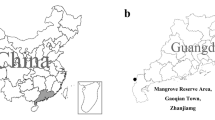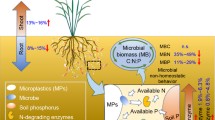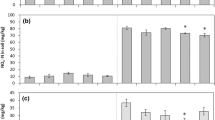Abstract
Mangroves, a major ecosystem for carbon sequestration, have been recently identified as a microplastic sink, yet the impact of microplastics on the mangrove microbial community is poorly known. Here, we investigated the metabolic activities of mangrove rhizosphere microbiome in the presence of polyethylene, polystyrene, polyamide, and polyvinylchloride, in microcosms, using Biolog™ Ecoplates. Results show that microbial communities in mangrove sediment hold their functional diversity and comprehensive metabolic activity within 56 days of microplastic exposure. However, polyamide and polyvinylchloride microplastics induced a 59.6–66.7% reduction in the rhizosphere microbes’ utilization for their preferred polymer carbon sources. Microbes exposed to polyethylene microplastics showed an activated biotransformation for nitrogen-contained carbon sources. Polyethylene and polyamide microplastics caused a 20.1–22.4% loss available nitrogen. Overall, microplastics are altering the carbon and nitrogen metabolism activities of microbiomes in mangrove wetlands.



Similar content being viewed by others
References
Amaral-ZettlerZettler LA et al (2020) Ecology of the plastisphere. Nat Rev Microbiol 18(3):139–151. https://doi.org/10.1038/s41579-019-0308-0
Banerjee K, Bal G, Mitra A (2018) In: Yadav Singh V, Yadava S, R, (eds) How soil texture affects the organic carbon load in the mangrove ecosystem? A Case study from Bhitarkanika Odisha. Environ Pollut. Water Science and Technology Library 77. Springer, Singapore. https://doi.org/10.1007/978-981-10-5792-2_27
Camacho-Valdez V, Ruiz-Luna A, Ghermandi A et al (2013) Valuation of ecosystem services provided by coastal wetlands in northwest Mexico. Ocean Coast Manage 78:1–11. https://doi.org/10.1016/j.ocecoaman.2013.02.017
Chia WY, Tang DYY, Khoo KS et al (2020) Nature’s fight against plastic pollution: algae for plastic biodegradation and bioplastics production. Environ Sci Ecotechnol 4:100065. https://doi.org/10.1016/j.ese.2020.100065
Classen AT, Boyle SI, Haskins KE et al (2003) Community-level physiological profiles of bacteria and fungi: plate type and incubation temperature influences on contrasting soils. Fems Microbiol Ecol 44(3):319–328. https://doi.org/10.1016/S0168-6496(03)00068-0
Daw TM, Hicks CC, Brown K et al (2016) Elasticity in ecosystem services: exploring the variable relationship between ecosystems and human well-being. Ecol Soc 21(2): 11. https://doi.org/10.5751/es-08173-210211
Deng H, He J, Feng D et al (2021) Microplastics pollution in mangrove ecosystems: a critical review of current knowledge and future directions. Sci Total Environ 753:142041. https://doi.org/10.1016/j.scitotenv.2020.142041
Donato DC, Kauffman JB, Murdiyarso D et al (2011) Mangroves among the most carbon-rich forests in the tropics. Nat Geosci 4:293–297. https://doi.org/10.1038/NGEO1123
Fuller S, Gautam A (2016) A procedure for measuring microplastics using pressurized fluid extraction. Environ Sci Technol 50(11):5774–5780. https://doi.org/10.1021/acs.est.6b00816
Garland JL, Mills AL (1991) Classification and characterization of heterotrophic microbial communities on the basis of patterns of community-level sole-carbon-source utilization. Appl Environ Microbiol 57(8):2351–2359. https://doi.org/10.1128/AEM.57.8.2351-2359.1991
Martin C, Almahasheer H, Duarte CM (2019) Mangrove forests as traps for marine litter. Environ Pollut 247:499–508. https://doi.org/10.1016/j.envpol.2019.01.067
Miao L, Wang C, Adyel TM et al (2020) Microbial carbon metabolic functions of biofilms on plastic debris influenced by the substrate types and environmental factors. Environ Int 143:106007. https://doi.org/10.1016/j.envint.2020.106007
Miao L, Yu Y, Adyel TM et al (2021) Distinct microbial metabolic activities of biofilms colonizing microplastics in three freshwater ecosystems. J Hazard Mater 403(5):123577. https://doi.org/10.1016/j.jhazmat.2020.123577
Sanders CJ, Smoak JM, Naidu AS et al (2010) Organic carbon burial in a mangrove forest, margin, and intertidal mud flat. Estuar Coast Shelf S 90(3):168–172. https://doi.org/10.1016/j.ecss.2010.08.013
Sun X, Tao R, Xu D et al (2023) Role of polyamide microplastic in altering microbial consortium and carbon and nitrogen cycles in a simulated agricultural soil microcosm. Chemosphere 312(1):137155. https://doi.org/10.1016/j.chemosphere.2022.137155
Turan V (2019) Confident performance of chitosan and pistachio shell biochar on reducing Ni bioavailability in soil and plant plus improved the soil enzymatic activities, antioxidant defense system and nutritional quality of lettuce. Ecotox Environ Safe 183(15):109594. https://doi.org/10.1016/j.ecoenv.2019.109594
Turan V, Khan SA, Mahmood UR et al (2018) Promoting the productivity and quality of brinjal aligned with heavy metals immobilization in a wastewater irrigated heavy metal polluted soil with biochar and chitosan. Ecotox Environ Safe 161:409–419. https://doi.org/10.1016/j.ecoenv.2018.05.082
Wang Z, Tsementzi D, Williams TC et al (2021) Environmental stability impacts the differential sensitivity of marine microbiomes to increases in temperature and acidity. Isme J 15(1):19–28. https://doi.org/10.1038/s41396-020-00748-2
Xie HF, Chen JJ, Feng LM et al (2021) Chemotaxis-selective colonization of mangrove rhizosphere microbes on nine different microplastics. Sci Total Environ 752:142223. https://doi.org/10.1016/j.scitotenv.2020.142223
Zuo LZ, Sun YX, Li HX et al (2020) Microplastics in mangrove sediments of the pearl river estuary, south china: correlation with halogenated flame retardants’ levels. Sci Total Environ 725:138344. https://doi.org/10.1016/j.scitotenv.2020.138344
Acknowledgements
We would like to thank Analytical and Testing Center of Guangdong Ocean University for the experimental guidance and help.
Funding
This work was supported by Project of Enhancing School with Innovation of Guangdong Ocean University (2020ZDZX2029), Shenzhen Science and Technology R&D Fund (KCXFZ202002011011057, JCYJ20210324122606017, and GJHZ20210705142000003), Postgraduate Education Innovation Project of Guangdong Ocean University (202147), and Training Project of Innovation and Entrepreneurship for Undergraduates (202110566033).
Author information
Authors and Affiliations
Contributions
HX performed experiments and writing—original draft preparation. BL helped with data curation. ZL performed experiments and revised the manuscript. ZL performed experiments. DL took part in data curation, and LH took part in investigation. ZD was involved in visualization. RS contributed to validation and formal analysis. SS participated in project administration. CL was responsible for system design supervision and funding acquisition.
Corresponding authors
Ethics declarations
Conflict of interest
The authors declare no conflicts of interest.
Additional information
Publisher's Note
Springer Nature remains neutral with regard to jurisdictional claims in published maps and institutional affiliations.
Supplementary Information
Below is the link to the electronic supplementary material.
Rights and permissions
Springer Nature or its licensor (e.g. a society or other partner) holds exclusive rights to this article under a publishing agreement with the author(s) or other rightsholder(s); author self-archiving of the accepted manuscript version of this article is solely governed by the terms of such publishing agreement and applicable law.
About this article
Cite this article
Xie, H., Li, B., Lu, Z. et al. Microplastics modify the microbial-mediated carbon metabolism in mangroves. Environ Chem Lett 22, 961–966 (2024). https://doi.org/10.1007/s10311-024-01704-8
Received:
Accepted:
Published:
Issue Date:
DOI: https://doi.org/10.1007/s10311-024-01704-8




